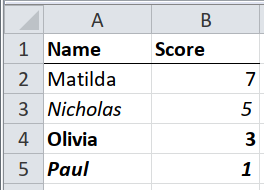2.6 Hierarchies in formatting

Different kinds of formatting might also represent different levels of a hierarchy, e.g.
| formatting | interpretation |
|---|---|
| none | good |
| italic | satisfactory |
| bold | poor |
| bold & italic | fail |
When each kind of formatting relates to a different level of one hierarchy,
import the different kinds of formatting into different columns, and then
combine them into a third column, perhaps using paste(), or case_when().
# Step 1: import the table taking only cell values and ignoring the formatting
x <- read_excel(path, sheet = "highlight-hierarchy")
x## # A tibble: 4 x 2
## Name Score
## <chr> <dbl>
## 1 Matilda 7
## 2 Nicholas 5
## 3 Olivia 3
## 4 Paul 1# Step 2: import one kind of formatting of one column of the table
# `formats` is a pallette of fill colours that can be indexed by the
# `local_format_id` of a given cell to get the fill colour of that cell
bold <- xlsx_formats(path)$local$font$bold
italic <- xlsx_formats(path)$local$font$italic
# Import all the cells, filter out the header row, filter for the first column,
# and create a new column `fill` of the fill colours, by looking up the
# local_format_id of each cell in the `formats` pallette.
formats <-
xlsx_cells(path, sheet = "highlight-hierarchy") %>%
dplyr::filter(row >= 2, col == 1) %>% # Omit the header row
mutate(bold = bold[local_format_id],
italic = italic[local_format_id]) %>%
mutate(grade = case_when(bold & italic ~ "fail",
bold ~ "poor",
italic ~ "satisfactory",
TRUE ~ "good")) %>%
select(bold, italic, grade)
# Step 3: append the `fill` column to the rest of the data
bind_cols(x, formats)## # A tibble: 4 x 5
## Name Score bold italic grade
## <chr> <dbl> <lgl> <lgl> <chr>
## 1 Matilda 7 FALSE FALSE good
## 2 Nicholas 5 FALSE TRUE satisfactory
## 3 Olivia 3 TRUE FALSE poor
## 4 Paul 1 TRUE TRUE failHere it is again, using only tidyxl and unpivotr.
bold <- xlsx_formats(path)$local$font$bold
italic <- xlsx_formats(path)$local$font$italic
xlsx_cells(path, sheet = "highlight-hierarchy") %>%
mutate(bold = bold[local_format_id],
italic = italic[local_format_id]) %>%
mutate(grade = case_when(bold & italic ~ "fail",
bold ~ "poor",
italic ~ "satisfactory",
TRUE ~ "good")) %>%
select(row, col, data_type, character, numeric, bold, italic, grade) %>%
behead("up", header) %>%
select(-col) %>%
spatter(header)## # A tibble: 4 x 6
## row bold italic grade Name Score
## <int> <lgl> <lgl> <chr> <chr> <dbl>
## 1 2 FALSE FALSE good Matilda 7
## 2 3 FALSE TRUE satisfactory Nicholas 5
## 3 4 TRUE FALSE poor Olivia 3
## 4 5 TRUE TRUE fail Paul 1